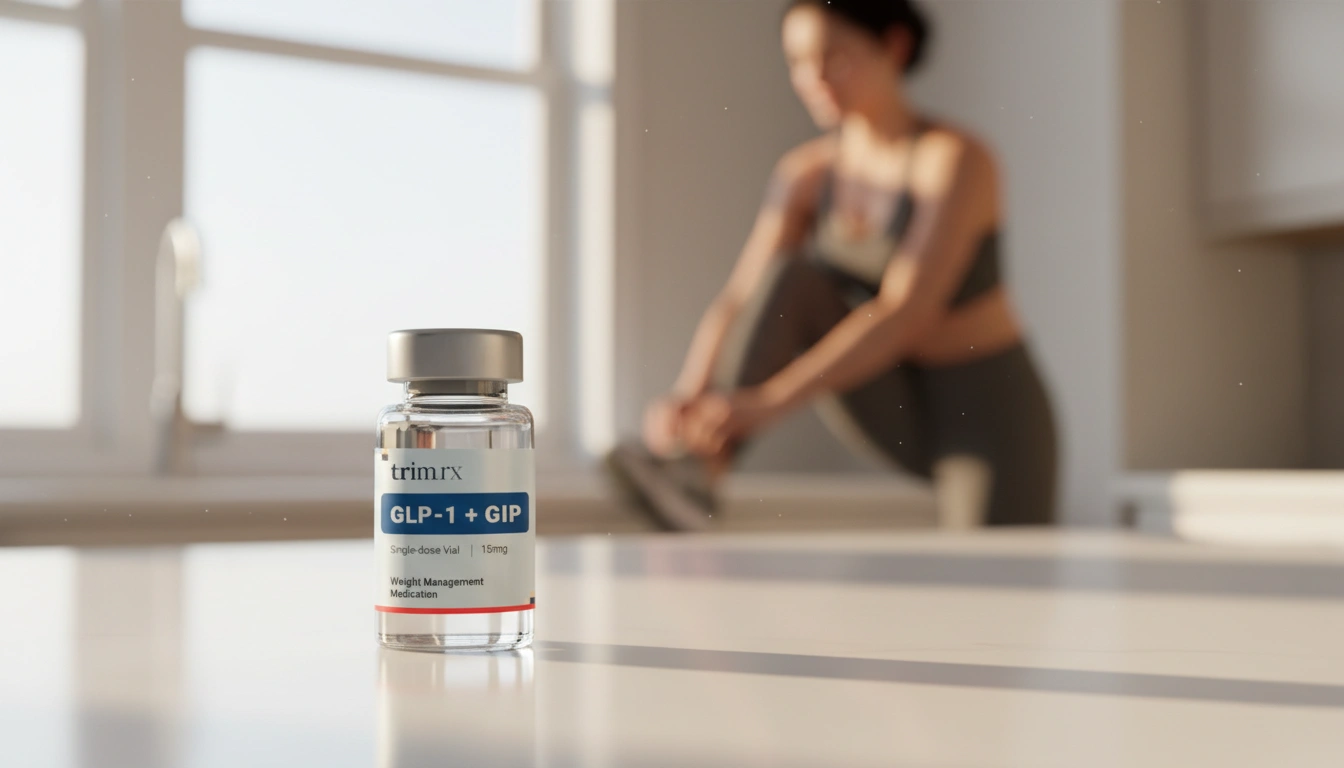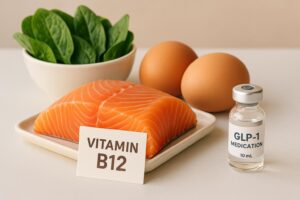Is There a Natural GLP-1? Exploring the Role of GLP-1 in Weight Management

Imagine a hormone that not only regulates your appetite but also plays a crucial role in managing blood sugar levels. This hormone, known as glucagon-like peptide-1 (GLP-1), has gained significant attention in recent years, especially with the rise of GLP-1 receptor agonist medications like Ozempic and Wegovy. While these medications have proven effective in promoting weight loss and controlling diabetes, many individuals are curious about whether there are natural ways to boost GLP-1 levels in the body.
In this blog post, we will delve into the science behind GLP-1, explore how it functions in our bodies, and examine various dietary and lifestyle strategies to enhance its natural production. By the end of this article, you’ll have a comprehensive understanding of GLP-1 and its implications for weight management, empowering you to make informed choices on your journey toward better health.
Introduction
Did you know that GLP-1 is a hormone that our bodies produce naturally after we eat? This hormone is released from the gut and plays a vital role in appetite regulation, insulin secretion, and glucose metabolism. However, with the increasing prevalence of obesity and metabolic disorders, the natural mechanisms that govern GLP-1 release can sometimes falter. This discrepancy raises the question: Is there a natural GLP-1?
Understanding GLP-1’s function and finding ways to enhance its levels naturally can be pivotal for those looking to manage their weight or improve their metabolic health.
In this article, we will explore:
- What GLP-1 is and how it functions in the body.
- The factors that influence GLP-1 production.
- Dietary and lifestyle changes that can naturally boost GLP-1 levels.
- The role of TrimRx’s personalized weight loss solutions in supporting individuals on their journey.
By providing a thorough exploration of these topics, we aim to equip you with actionable insights that can enhance your understanding of GLP-1 and its potential benefits.
Understanding GLP-1: The Basics
GLP-1 is an incretin hormone, which means it is released in response to food intake. It helps regulate blood sugar levels by stimulating insulin secretion from the pancreas and inhibiting glucagon release, a hormone that raises blood sugar. In addition to its role in glucose metabolism, GLP-1 slows gastric emptying, which promotes a feeling of fullness and reduces appetite.
The Importance of GLP-1
The significance of GLP-1 cannot be overstated, especially in the context of weight management and metabolic health. Research has shown that individuals with obesity often experience impaired GLP-1 secretion, which can contribute to overeating and weight gain.
Studies indicate that increasing GLP-1 levels can lead to:
- Improved appetite regulation
- Enhanced insulin sensitivity
- Better blood sugar control
- Potential weight loss
Given these benefits, it is understandable why individuals are exploring ways to naturally enhance their GLP-1 levels.
Factors Influencing GLP-1 Production
Several factors can affect how much GLP-1 your body produces. Understanding these can help you identify strategies to naturally boost your levels.
1. Dietary Choices
The types of foods we consume play a crucial role in GLP-1 production. Foods high in protein, fiber, and healthy fats are known to stimulate GLP-1 release.
Protein: Foods like eggs, lean meats, and legumes are rich in protein, which has been shown to increase GLP-1 secretion. For instance, consuming a protein-rich meal can lead to higher GLP-1 levels compared to a carbohydrate-heavy meal.
Fiber: High-fiber foods, such as whole grains, fruits, and vegetables, are particularly effective in promoting GLP-1 production. Research has shown that soluble fibers, such as beta-glucan found in oats and barley, can significantly enhance GLP-1 release.
Healthy Fats: Foods rich in healthy fats, such as avocados and olive oil, also contribute to GLP-1 secretion. These fats help slow digestion and promote satiety.
2. Gut Health
The health of our gut microbiome has a profound impact on GLP-1 production. A diverse and balanced gut microbiome can enhance the fermentation of dietary fibers, leading to the production of short-chain fatty acids (SCFAs), which stimulate GLP-1 release.
3. Physical Activity
Exercise has been shown to increase GLP-1 levels in the body. Regular physical activity, including both aerobic and resistance training, can enhance insulin sensitivity and promote a favorable metabolic profile, leading to increased GLP-1 secretion.
4. Hormonal Balance
Hormonal fluctuations can impact GLP-1 levels. For example, women may experience variations in GLP-1 production during different phases of their menstrual cycle. Additionally, conditions such as obesity and insulin resistance can disrupt normal GLP-1 secretion, making it essential to address underlying hormonal imbalances.
Dietary Strategies to Boost Natural GLP-1 Levels
Now that we understand the factors influencing GLP-1 production, let’s explore practical dietary strategies that can help enhance its levels naturally.
1. Incorporate High-Protein Foods
Including a variety of protein sources in your diet can effectively boost GLP-1 levels. Aim to incorporate foods such as:
- Eggs
- Lean meats (chicken, turkey, fish)
- Plant-based proteins (legumes, tofu, tempeh)
2. Increase Fiber Intake
High-fiber foods are essential for promoting GLP-1 secretion. Focus on incorporating the following into your meals:
- Whole grains (oats, barley, quinoa)
- Fruits (berries, apples, pears)
- Vegetables (broccoli, Brussels sprouts, leafy greens)
3. Emphasize Healthy Fats
Healthy fats can enhance GLP-1 production while providing satiety. Include sources such as:
- Avocados
- Nuts (almonds, walnuts)
- Olive oil
4. Stay Hydrated
Adequate hydration is crucial for overall health and can aid in digestion, which in turn supports GLP-1 production. Aim to drink plenty of water throughout the day.
5. Consider Probiotic and Prebiotic Foods
Probiotic-rich foods, such as yogurt and fermented vegetables, can enhance gut health, while prebiotics (found in foods like garlic, onions, and bananas) can nourish beneficial gut bacteria, promoting SCFA production and stimulating GLP-1 release.
The Role of TrimRx in Your Weight Loss Journey
At TrimRx, we believe that sustainable weight loss should be achieved through science, empathy, and a transparent approach. Our journey began with a shared vision to help individuals embrace healthier lifestyles by merging cutting-edge telehealth innovations with effective weight loss solutions.
We offer a personalized weight loss program that includes a comprehensive assessment to determine your eligibility for our prescription medications, such as Semaglutide and Tirzepatide. These medications have been clinically proven to aid weight loss by mimicking the effects of GLP-1, helping you achieve your weight loss goals safely and effectively.
If you’re interested in discovering if you qualify for our prescription weight loss medications, we encourage you to take our free assessment quiz here.
In addition to our personalized programs, we also offer quick-access supplements that can support your weight loss journey. Our GLP-1 Daily Support and Weight Loss Boost supplements are designed to complement your efforts and help you achieve your goals. You can explore these options here and here.
Lifestyle Changes to Support GLP-1 Production
In addition to dietary strategies, certain lifestyle changes can further enhance GLP-1 levels and support your overall health.
1. Regular Physical Activity
As mentioned earlier, exercise plays a crucial role in increasing GLP-1 production. Aim for at least 150 minutes of moderate-intensity aerobic activity each week, along with strength training exercises twice a week. Activities such as walking, cycling, swimming, and resistance training can all contribute to improved metabolic health.
2. Manage Stress
Chronic stress can negatively impact hormone balance, including GLP-1 levels. Incorporating stress management techniques such as mindfulness, meditation, yoga, or deep breathing exercises can help reduce stress and promote hormonal balance.
3. Prioritize Sleep
Quality sleep is essential for overall health and hormone regulation. Aim for 7-9 hours of sleep per night to support metabolic function and optimize GLP-1 secretion.
4. Avoid Processed Foods
Minimizing your intake of highly processed foods can help promote better gut health and support GLP-1 production. Focus on whole, nutrient-dense foods that nourish your body and support your metabolic health.
Conclusion
The quest for natural ways to boost GLP-1 levels is an exciting area of research with significant implications for weight management and metabolic health. By understanding the factors that influence GLP-1 production and implementing dietary and lifestyle strategies, we can harness the power of this hormone to support our weight loss goals.
At TrimRx, we are committed to providing personalized weight loss solutions that empower individuals to embrace healthier lifestyles. Whether through our prescription medications or quick-access supplements, we stand by our mission to support you on your journey to sustainable weight loss.
If you’re ready to take the first step towards achieving your weight loss goals, we invite you to take our free assessment quiz here and explore our quick-access supplements here and here.
FAQ
What is GLP-1?
GLP-1, or glucagon-like peptide-1, is a hormone produced in the gut that plays a crucial role in regulating appetite, insulin secretion, and glucose metabolism.
How can I increase my GLP-1 levels naturally?
You can increase GLP-1 levels by consuming high-protein and high-fiber foods, staying hydrated, engaging in regular physical activity, managing stress, and prioritizing quality sleep.
Are there any supplements that can boost GLP-1?
While some products claim to boost GLP-1 levels, it’s essential to consult with your healthcare provider before trying any supplement. The effectiveness and safety of many supplements are not well-regulated.
Can TrimRx help me with my weight loss journey?
Yes! TrimRx offers personalized weight loss solutions, including prescription medications and quick-access supplements, designed to support your weight loss goals safely and effectively. Take our free assessment quiz to see if you qualify!
Is it safe to take GLP-1 medications?
GLP-1 medications, such as Semaglutide and Tirzepatide, are clinically proven for weight loss and diabetes management. However, it’s essential to consult with your healthcare provider to determine if they are right for you.

Transforming Lives, One Step at a Time
Keep reading
Vitamin B12 and GLP-1 Medications: What to Know
GLP-1 medications can lower B12 absorption and intake; learn symptoms, food sources, supplement options, and how to monitor levels.
Semaglutide Injection Site Reactions: What To Know
Learn why semaglutide injections can cause redness, swelling or nodules, how to prevent and treat them, and when to seek medical care.
TrimRx vs Friday’s
Compare TrimRx and Friday’s telehealth GLP-1 weight-loss programs: pricing, medical support, coaching, delivery, and which fits your needs.



